Twelve pre-school children stream down a corridor of a Co Meath nursing home and into the large activities room where more than a dozen residents are eagerly waiting their arrival.
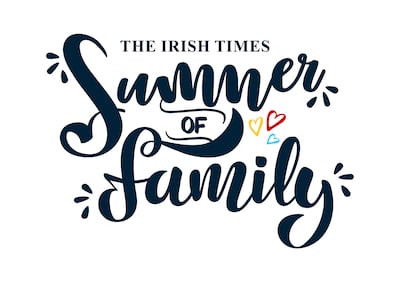
One woman opens wide her arms in welcome from a chair on the far side of the room and a boy goes running to reciprocate the greeting. For these two groups at either end of life’s spectrum, the pleasure of this weekly interaction is clearly mutual.
Every Monday, a group of pre-schoolers put on hi-viz waistcoats and make the five-minute walk from Happy Days in Ratoath village’s community centre, known as The Venue, to Silver Stream Ratoath Manor Nursing Home, which has 57 residents. Passersby smile as the tots go hand-in-hand in pairs through the Village Centre opened by Bertie Ahern in 2001, past the 1950s Marian shrine, the Auld Stand pub, a Chinese takeaway and betting shop, to be shepherded across the road by their accompanying educators and into the manor grounds.
Once inside the activities room, the little ones swarm around small tables already set up with a selection of toys from their pre-school. Two or three residents sit close to each table, a willing and participatory audience as the children do what children do – playing away and happy to show onlookers how it’s done.
At home with Brendan Courtney by the sea in Wicklow: ‘I wanted to simplify my life’
Wealth gap tensions: ‘My friends don’t have to budget like me. A round of cocktails scares the s**t out of me’
Alison Curtis: ‘On arriving in Ireland I was stumped at how men and women didn’t interact’
‘I’m deeply unhappy but I think leaving my husband will destroy him’
In one armchair, Mary Lawlor from Galway who has been here just two weeks, says they were all looking forward to the children coming. Ella, whose red hair is neatly plaited into pig tails, is making a Lego building on the table beside her. Asked by this reporter if she, Ella, might live in that house, the little girl scoffs such a ludicrous idea and rightly points out that only “small people” can go in there.
Mary Treacy, one of the home’s activities organisers, says residents love these visits. “They are always asking when are the children coming and are in great spirits afterwards all day.”
Children reap social, emotional and developmental benefits from the individualised attention and feedback they get from older people
John Donoghue, sporting a summer boater, is another resident clearly happy to see the children arriving. “They get stuck in. I love that. They are very cute.”
“How do you break this?” a blond-haired boy called CJ asks as he struggles to remove a hat off a Potato Head toy. Donoghue has a try. “I don’t know if it is coming or going,” he remarks as he fails to remove it and CJ takes it back.
Then the boy lifts black spectacles off another head and holds them up against the man’s own, remarking on his white moustache as he does so. When the educators announce it is time to go, the two hug and CJ, with no doubt the better memory for names, says “goodbye John” as he leaves his side.
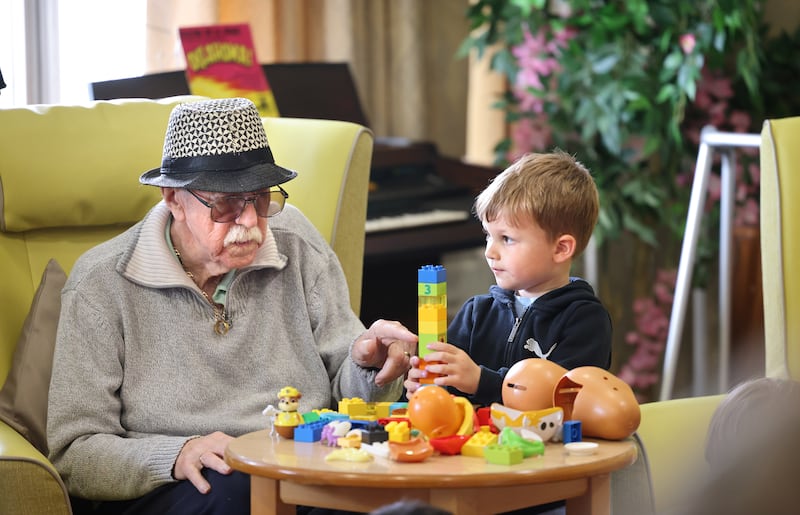
This is what intergenerational learning (IGL) as “a pedagogical strategy” looks like in practice. It is “win-win”, says Dr Anne Fitzpatrick of Technological University Dublin (TUD), author of Generations Growing Together, a handbook about how to incorporate IGL into early-years care and education services. Abilities of both our youngest and oldest citizens can be underestimated by the rest of society, which organises age-segregated care for them behind closed doors – be it in a childcare setting or nursing home.
“There’s an awful lot of talk about children having rights and being seen as fully fledged citizens and yet there isn’t really many opportunities for that,” says Fitzpatrick. “This is one where they’re actually out there and they are contributing by their energy and their vitality to the community and to an older person’s group.”
Children reap social, emotional and developmental benefits from the individualised attention and feedback they get from older people. Senior citizens, in turn, have the opportunity for lifelong learning and a sense of purpose in sharing their values, skills and wisdom with children.
“We talk about intergenerational learning, too, as a slow pedagogy,” says Fitzpatrick. Typically, small children are quite rushed, whether it is going through a day’s pre-school programme or out and about with busy parents.
“By taking this kind of approach, it gives children time to relax and to get confident in speaking to an older person and dealing with a new environment.” It is very different to the more controlled surroundings of an early-years setting, she points out, so it stretches them.
For Happy Days pre-school, the practice of IGL started back in 2016, after their children went to the nursing home to give a Christmas concert. It was such a positive experience for both sides, their visits evolved into a weekly event.
The current manager, Mary Barron, who started working here in May of last year, had no doubt it was something she wanted to continue. “I’ve seen first-hand how important it is for the residents and how important it is for the children.” Those attending the pre-school are also involved with more active older adults in the local Tidy Towns group.
The community centre where Happy Days is housed operates on the basis that it is a place for all to enjoy, aged “three or 93″, says its chief executive, Laura Murphy. A volunteer on the board of Special Olympics Ireland, she champions centre initiatives that can involve a wide mix of ages and abilities.
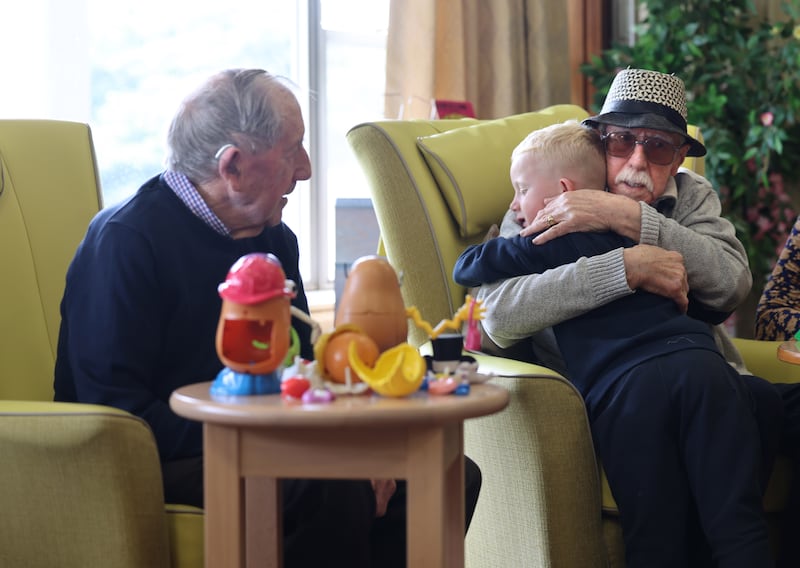
Making any intergenerational activity a regular feature is essential because its success depends on building relationships, explains Fitzpatrick. Visits to a local nursing home is one way to do it; other centres favour having “social grandparents” come into them. “IGL requires time for children and older adults to feel comfortable with each other. It is the quality of the interactions rather than the completion of any activity that is the key feature of successful IGL practice.”
Fitzpatrick developed a particular interest in this area after TUD, then the Dublin Institute of Technology, was involved in founding the Together Old + Young (Toy) project that started in 2012 and included six other European countries. Recognising modern trends of increased age segregation, it aims to build all-age-friendly communities and enhance social cohesion.
It is a relatively recent development here in Ireland that nearly all children spend two years in pre-school – and many have attended a childcare setting before that. They generally have less opportunity to spend time with grandparents, particularly if they live overseas. Karen Cullen, an educator with Happy Days, says you can always tell the children who are used to interacting with their own grandparents as they are straight into the action at the nursing home, while others are initially more reserved.
[ Irish nursing home groups rack up losses after wave of overseas takeoversOpens in new window ]
Fitzpatrick researched the impact of IGL in five early-years settings for her PhD. “I looked at what the children said, what the parents said and what the educators said.” Feedback was overwhelmingly positive. “We expected that parents would be maybe nervous about their child being brought into a different environment. Almost without fail, every parent said, ‘I would like my child to be doing that’,” she reports. Some parents even said they had chosen a service because of the IGL approach.
Lee Chambers, whose four-year-old daughter Grace attends Happy Days, is one such parent. “It is what attracted us to the pre-school,” she says. “I think it is so beneficial.” Chambers’s own mother is a youthful grandmother in her early 60s, so these visits give Grace and her peers a chance to learn about a generation beyond that. “They are learning how to be gentle and empathetic. They don’t go in with any judgment,” says Chambers, who does not get too much information from her daughter about the visits, although “a lady with a pink cardigan” has had favourable mention.
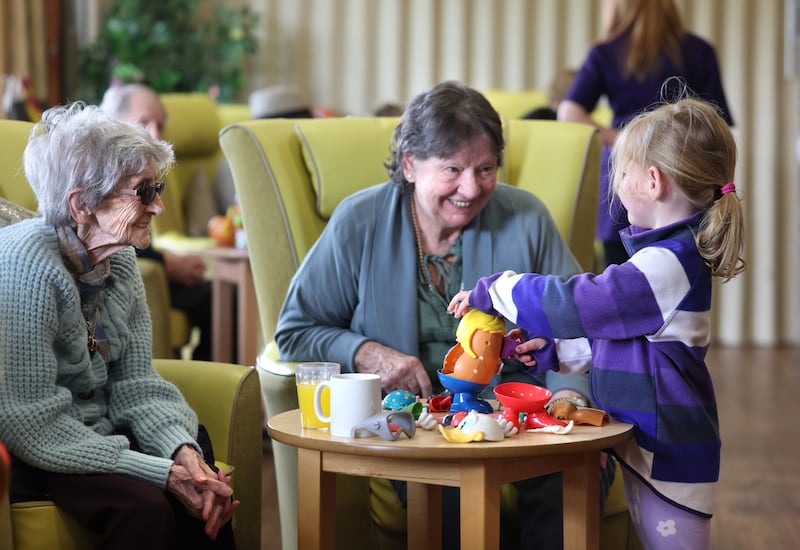
The focus of IGL research has been mostly on activities involving what Fitzpatrick calls the “older old” ie those attending day centres or in residential homes. “But we know that there’s a huge opportunity also for the ‘younger old’: the active retired, the men’s sheds, the tidy towns [groups etc].” It’s actually not good for children to think that all older people have hearing loss, or are confined to a chair, she comments.
In these days of heightened “health and safety” concerns, IGL requires educators, “who are innovative, courageous and confident to go beyond what is ‘safe’, to discover what is possible”. It is the easier option not to venture out into the community with pre-schoolers.
“We know from talking with people who have done it, it is manageable and you can manage those risks,” she says. One of the problems for children in many early-year services is that they’re not challenged enough and IGL gives even the educators an opportunity to stretch their own horizons.
[ Elder advocate defends new regime to protect rights of the elderlyOpens in new window ]
Karen O’Grady, owner of It’s a Small World Montessori pre-school in Raheny, Dublin, is one of those courageous educators. She and her staff take groups of children to Raheny House Nursing Home, about 15 minutes’ walk away, every Monday afternoon and Wednesday morning.
The idea came to O’Grady as she witnessed the close relationship between her own parents and children and recalled her own close bond with her grandparents. Her staff were fully supportive when she told them she had a “crackpot” idea to contact the local nursing home to see if they would be open to the proposition.
“It was such a wonderful experience,” she says of those early visits. “The children just connected.” The empathy of the children among the older people has to be seen to be believed, suggests O’Grady, who found a training course to do on IGL after they had started it, “just to make sure I was doing the right thing”.
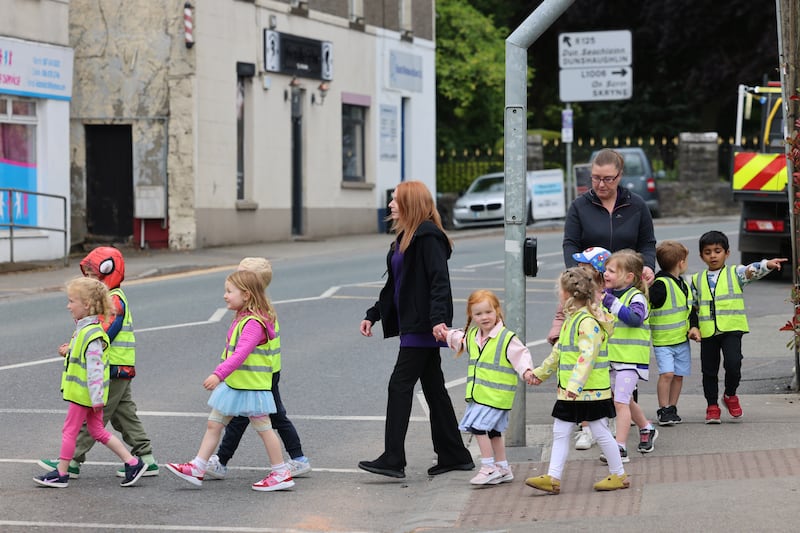
It works well for children with special needs too, in smaller numbers. She prepares them with social stories, illustrated with photographs of Raheny House and talking them through what will happen on the visit.
Having started well before Covid-19, she wasn’t sure how welcome their return to the nursing home might be after the pandemic. In the interim they had some of the children’s own grandparents coming into the pre-school to continue IGL. But O’Grady was delighted when it was the home that contacted her about resuming visits.
The way the children spend their time in the nursing home depends partly on what materials they bring with them, be it toys, games, arts or crafts. The home also has its own equipment that the children are free to play with. O’Grady laughingly recalls one session where the children got stuck into some soft balls used there “as if they were on a GAA pitch” and they were flying around the room. That was one activity they didn’t repeat.
After returning to the pre-school, each child is invited to draw a picture of their visit to Raheny House and talk about what they have drawn. This helps staff document and gauge the impact of IGL.
[ Loneliness and the elderly: ‘The deafening sound of silence’Opens in new window ]
“It has been very successful for us as a school,” says O’Grady. Inevitably, on occasion, there will be an empty chair in the nursing home where a resident they got to know used to sit. Small children take this in their stride and move on, says O’Grady, but she and her staff can feel the loss.
Richness of collaborations across the age span is celebrated at an annual Creative Generations festival in Atlantic Technological University, Sligo. It evolved out of a module on intergenerational learning introduced by Kate Brown, who lectures to both early-education and social care students, and the event now ties in with Global Intergenerational Awareness Week in April.
It’s actually not good for children to think that all older people have hearing loss or are confined to a chair
One of the highlights for Brown this year was students who were facilitating events reporting back on how little they had to do, as relationships were forged through shared activities in front of their eyes. When older people and children gather in one place, “the work kind of takes on a life form of its own”, she says. They did activities together such as baking and traditional crafts of butter-making and weaving.
Another highlight for Brown was Babydance, where babies under the age of two and grandparents were introduced to world music through a live DJ. “What we loved about that was that there’s no need for verbal communication; of course it’s all done through movement and dance. The words kind of slip away, which is lovely.” A children’s photography competition also revealed how many youngsters use digital media very creatively to keep in touch with grandparents living abroad.
Brown was drawn to IGL because of her own grandmother, Alice Tyrrell (née Darcy) of Dundalk, Co Louth, who was a very positive role model in her life. “She was a woman who had great style and understood the value of wearing a good hat.” She had worked as a district nurse in the UK during the second World War but could not get a permanent job on her return to Ireland, due to the marriage bar. She became “quite a trailblazer” in the Irish Nurses’ Organisation (now the Irish Nurses’ and Midwives’ Organisation) in campaigning for legislative change.
“She was just really lovely to be around and she took an interest in us,” Brown says about her grandmother who died in 2003. “I suppose because I was the eldest girl, we just had that lovely bond.”
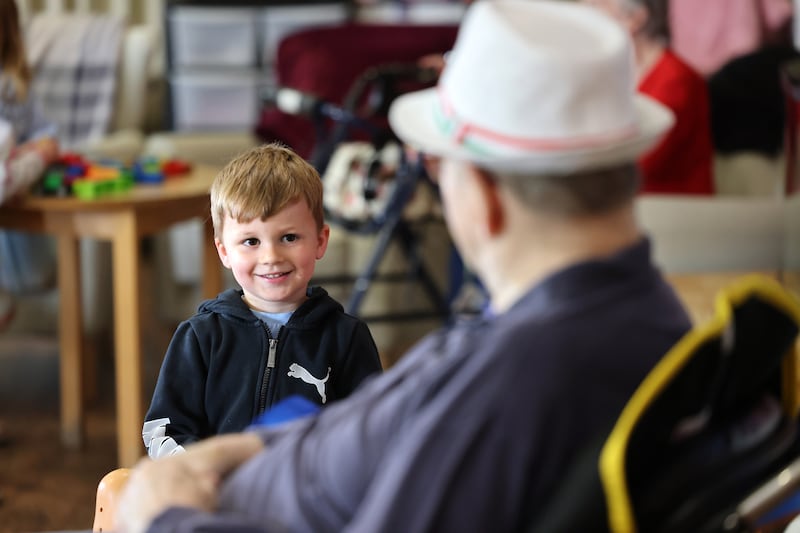
At the conclusion of the Ratoath Manor visit, the children clamber on the stage in the activities hall to recite “I wonder” by Jeannie Kirby: “I wonder why the grass is green and why the wind is never seen…”
They are polishing their performance for graduation day. After a round of applause, it’s time for the return walk to the community centre, with chocolate treats on departure for each child in the safe custody of Barron. Back at base, they will be debriefed the following morning on the visit.
Staff capture comments to write into a big, dedicated journal, along with photos, for a permanent log of these transient but character-forming experiences for the pre-schoolers.
- Sign up for push alerts and have the best news, analysis and comment delivered directly to your phone
- Join The Irish Times on WhatsApp and stay up to date
- Listen to our Inside Politics podcast for the best political chat and analysis











